Northrop F-89 Scorpion
| F-89 Scorpion | |
|---|---|
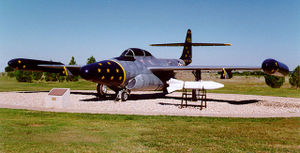 |
|
| USAF F-89H-1-NO Scorpion, 54-264. | |
| Role | Interceptor |
| Manufacturer | Northrop Corporation |
| First flight | 16 August 1948 |
| Introduced | September 1950 |
| Retired | 1969 |
| Primary users | United States Air Force Air National Guard |
| Number built | 1,050 |
| Unit cost | US$801,602 (F-89D)[1] US$988,884 (F-89H)[2] |
The Northrop F-89 Scorpion was an early American jet-powered fighter designed from the outset as an all-weather interceptor. Though its straight wings limited its performance, it was among the first USAF jet fighters equipped to fire guided missiles, including the distinction of being the first combat aircraft armed with nuclear weapons (the unguided Genie rocket) for air-to-air use.
Contents |
Design and development
The Scorpion stemmed from a 1945 United States Army Air Forces Army Air Technical Service Command specification ("Military Characteristics for All-Weather Fighting Aircraft") for a jet-powered night fighter to replace the P-61 Black Widow.[3] Bell Aircraft, Consolidated-Vultee, Douglas Aircraft, Goodyear, Northrop and Curtiss-Wright all submitted proposals.
Northrop submitted four different designs, prepared by Jack Northrop's team, including a radical flying wing but settled on the N-24, a slim-bodied aircraft with a cantilevered mid-mounted wing and two Allison J35 turbojet engines with afterburners.[3] It was to have radar and a crew of two, with an armament of four 20 mm (.79 in) cannon in a unique trainable nose turret.[4] One of the unusual aspects of the design was the use of Northrop's "Deceleron", a combination aileron/dive brake/flap that could be accommodated in the slim wing design.[3] The unique feature added to the prototype during development was to become a Northrop trademark, still used today on the B-2 Spirit. Contracts for two prototypes were issued in December 1946, while Douglas with their XF3D-1 Skynight and Curtiss for their XF-87 Blackhawk prototypes also were awarded development contracts.[3]
The initial XP-89 prototype made its first flight on 16 August 1948, with test pilot Fred C. Bretcher at the controls.[4] For much of the testing period, Curtiss's entry had been the front-runner for the contract, but in a competition fly-off with its main competitors, the Northrop design proved superior.[5] Other USAF interceptors such as the F-94 Starfire and F-86 Sabre had been adapted from day fighter designs.
Operational history
Production was authorized in January 1949,[6] with the first production F-89A flying in September 1950. It had AN/APG-33 radar and an armament of six 20 mm (.79 in) T-31 cannons with 200 rpg. The swiveling nose turret was abandoned, and 300 US gal (1,100 l) fuel tanks were permanently fitted to the wingtips. Underwing racks could carry 16 5 in (127 mm) aerial rockets or up to 3,200 lb (1,455 kg) of bombs.[7]
Only eighteen F-89As were completed, which were mainly used for tests and trials, before the type was upgraded to F-89B standard, with new avionics.[7] The type entered service with the 84th Fighter-Interceptor Squadron in June 1951.[8] These had considerable problems with engines and other systems, and soon gave way to the F-89C. Despite repeated engine changes, problems persisted, compounded by the discovery of structural problems with the wings that led to the grounding of the F-89 and forced a refit of 194 -A, -B, and -C models.[9]
The major production model was the F-89D, which first flew 23 October 1951 and entered service in 1954. It removed the cannon in favor of a new Hughes E-6 fire control system with AN/APG-40 radar and an AN/APA-84 computer. Armament was two pods of 52 2.75 in (70 mm) "Mighty Mouse" FFAR rockets, for a total of 104.[10] A total of 682 were built.[1]
Proposed re-engined F-89s, designated F-89E and F-89F, were not built, nor was a proposed F-89G that would have used Hughes MA-1 fire control and GAR-1/GAR-2 Falcon air-to-air missiles like the F-102 Delta Dagger.
The subsequent F-89H, which entered service in 1956, had an E-9 fire control system like that of the early F-102 and massive new wingtip pods each holding three Falcons (usually three semi-active radar homing GAR-1s and three infrared GAR-2s) and 21 FFARs, for a total of six missiles and 42 rockets. Problems with the fire control system delayed the -H's entry into service, by which time its performance was notably inferior to newer supersonic interceptors, so it was phased out of USAF service by 1959.
The final variant was the F-89J. This was based on the F-89D, but replaced the standard wingtip missile pod/tanks with 600 gal (2,271 l) fuel tanks and fitted a pylon under each wing for a single MB-1 Genie nuclear rocket (sometimes supplemented by up to four conventional Falcon air-to-air missiles). The F-89J became the only aircraft to fire a live Genie as the John Shot of Operation Plumbbob on 19 July 1957. There were no new-build F-89Js, but 350 -Ds were modified to this standard. They served with the Air Defense Command, later renamed the Aerospace Defense Command (ADC), through 1959 and with ADC-gained units of the Air National Guard through 1969. This version of the aircraft was extensively used within the Semi Automatic Ground Environment (SAGE) air defense system.
A total of 1,050 Scorpions of all variants were produced.
Variants
- XF-89
- First prototype.
- XF-89A
- Second prototype.
- F-89A
- First production version, eight built.
- F-89B
- Second production version with upgraded avionics.
- F-89C
- Third production version with new engines.
- F-89D
- Main production version which saw deletion of the six 20 mm (.79 in) cannons in favor of 104 rockets in wing pods, installation of new Hughes E-6 fire control system, AN/APG-40 radar and the AN/APA-84 computer. This new system allowed the use of a lead-collision attack in place of the previous lead-pursuit-curve technique. A total of 682 built.
- YF-89E
- One off prototype to test the Allison YJ71 engine.
- F-89F
- Proposed version with new engines, never built.
- F-89G
- Proposed version equipped with Hughes MA-1 fire control and GAR-1/GAR-2 Falcon air-to-air missiles, never built.
- F-89H
- Version with E-9 fire control system, six GAR-1/GAR-2 Falcon missiles and 42 Folding Fin Areal Rockets (FFAR).
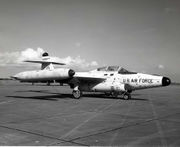
- F-89J
- Last production version, developed from F-89D by replacing the standard wingtip missile pod/tanks with fuel tanks. Underwing hardpoints allowed for carriage of up to two AIR-2|MB-1 Genies, or at least four Falcon missiles, or a combination (though this was not generally done in practice). A total of 350 were rebuilt from F-89Ds.
- DF-89A
- F-89As converted into drone control aircraft.
- DF-89B
- F-89Bs converted into drone control aircraft.
Operators
- United States Air Force
- Air National Guard
Survivors
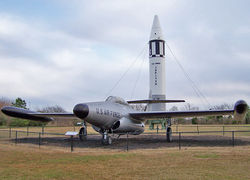
There are more than 20 complete F-89s are currently on display in the United States. The following is an incomplete list.
- F-89B s/n 49-2434
- Disasasembled at the Texas Air Museum in San Antonio, Texas. Formerly on display at the USAF History and Traditions Museum at Lackland AFB also in San Antonio.
- F-89B s/n 49-2457
- Ex-190th FIS, Idaho ANG. On display at Lakeview Park, Nampa, Idaho since 1959.
- F-89D s/n 52-1862
- On display at the Heritage Park, Elmendorf Air Force Base, Alaska painted in the historic markings of 53-2433. Formerly on display at Tyndall AFB, Florida.[11]
- F-89D s/n 52-1883
- On display at Edwards Air Force Base, California. Formerly displayed at Ethan Allen AFB / Burlington Air National Guard Base, Vermont.
- F-89D s/n 52-1959
- Stored for the Air Force Test Center Museum, Edwards Air Force Base, California.
- F-89D s/n 53-2463
- On display at the Museum of Aviation, Robins Air Force Base, Georgia.
- F-89D s/n 53-2494
- On display at the home base of the 158th Fighter Wing, Vermont Air National Guard, Burlington Air National Guard Base, Vermont.
- F-89D/J s/n 53-2536,
- On display at the AirVenture Museum, Oshkosh, Wisconsin.[12]
- F-89D/J s/n 53-2677
- Ex-Wisconsin ANG, Ex-Minnesota ANG. On display at the Minnesota Air National Guard Museum, Minneapolis, Minnesota. Former Commemorative Air Force display in Harlingen, Texas.
- F-89H s/n 54-0298
- On display at Dyess Linear Air Park, Dyess Air Force Base, Texas.
- F-89H s/n 54-0322
- On display at the Hill Aerospace Museum, Hill Air Force Base, Utah.
- F-89J s/n 52-1856
- Ex-132 FIS, Dow AFB, Maine. Currently on display at Bangor International Airport / Dow Air National Guard Base, Maine.
- F-89J s/n 52-1868
- Reportedly for sale at Cable, California airport. Ex-Carswell AFB, TX
- F-89J s/n 52-1896
- New England Air Museum, Windsor Locks, Connecticut.
- F-89J s/n 52-1911
- On display as "53-2509" at the National Museum of the United States Air Force, Wright-Patterson Air Force Base, Dayton, Ohio. This aircraft was the last F-89 remaining in service when it was transferred to the Museum from the Maine Air National Guard in July 1969.[13]
- F-89J s/n 52-1927
- On display at the Castle Air Museum (former Castle AFB), Atwater, California.
- F-89J s/n 52-1941
- On display at the Peterson Air & Space Museum, Peterson Air Force Base, Colorado.
- F-89J s/n 52-1949
- On display at the March Field Air Museum, March Air Reserve Base, Riverside, California.
- F-89J s/n 52-2129
- On display at the Air Power Park and Museum, Hampton, Virginia.
- F-89J s/n 53-2453
- Under restoration by the Heritage Flight Museum, Bellingham, Washington. Formerly displayed at Helena, Montana airport.
- F-89J s/n 53-2519
- Reported at the Planes of Fame Museum, Chino, California.
- F-89J s/n 53-2465
- On display at the home base of the 119th Fighter Wing, North Dakota Air National Guard, Fargo, North Dakota.
-
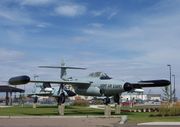 F-89J s/n 53-2547
F-89J s/n 53-2547 - F-89J s/n 53-2547
- On display at the home base of the 120th Fighter Wing, Montana Air National Guard, Great Falls, Montana. This jet fired the live Genie described above.
- F-89J s/n 53-2610
- On display at the Air Force Armament Museum, Eglin Air Force Base, Florida - last assigned to the 119th Fighter Wing, North Dakota Air National Guard.
- F-89J s/n 53-2646
- in Friendship Park, Smithfield, Ohio. Formerly at Florence, S.C.
- F-89J s/n 53-2674
- On display at the Pima Air & Space Museum, Tucson, Arizona.
Specifications (F-89D)
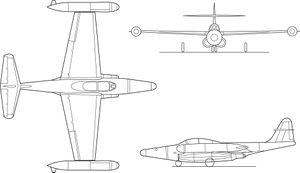
Data from Scorpion with a Nuclear Sting [14]
General characteristics
- Crew: 2
- Length: 53 ft 9½ in (16.40 m)
- Wingspan: 59 ft 8½ in (18.20 m)
- Height: 17 ft 6 in (5.33 m)
- Wing area: 606 ft² (56.30 m²)
- Empty weight: 25,194 lb (11,428 kg)
- Loaded weight: 37,190 lb (16,869 kg)
- Max takeoff weight: 42,241 lb (19,161 kg)
- Powerplant: 2× Allison J35-A-35 afterburning turbojets
- Dry thrust: 5,440 lbf (24.26 kN) each
- Thrust with afterburner: 7,200 lbf (32.11 kN) each
Performance
- Maximum speed: 635 mph (552 knots, 1,022 km/h) at 10,600 ft (3,200 m)
- Ferry range: 1,366 mi (1,188 nm, 2,200 km)
- Service ceiling: 49,200 ft (15,000 m)
- Rate of climb: 7,440 ft/min (37.8 m/s)
Armament
- Rockets:
- 104× 2.75 in (70 mm) "Mighty Mouse" folding-fin aerial rockets
- 16× 5 in (127 mm) aerial rockets on underwing racks or
- Bombs: 3,200 lb (1,500 kg)
See also
Comparable aircraft
- Avro Canada CF-100
- Lockheed F-94 Starfire
- North American F-86D Sabre Dog
- Sud Aviation Vautour
- Yakovlev Yak-25
Related lists
- List of military aircraft of the United States
- List of fighter aircraft
References
- Notes
- ↑ 1.0 1.1 Knaack 1978, p. 93.
- ↑ Knaack 1978, p. 96.
- ↑ 3.0 3.1 3.2 3.3 Davis and Menard 1990, p. 4.
- ↑ 4.0 4.1 Air International July 1988, p. 46.
- ↑ Davis and Menard 1990, p. 5.
- ↑ Knaack 1978, p. 85.
- ↑ 7.0 7.1 Air International July 1988, pp. 47–48.
- ↑ Knaack 1978, p. 87.
- ↑ Knaack 1978, pp. 88–89.
- ↑ Air International August 1988, pp. 88–89.
- ↑ "F-89D." abpic.co.uk. Retrieved: 28 August 2010.
- ↑ "F-89J." airventuremuseum.org. Retrieved: 28 August 2010.
- ↑ United States Air Force Museum Guidebook 1975, p. 66.
- ↑ Air International July 1988, p. 49.
- Bibliography
- Davis, Larry and Dave Menard. F-89 Scorpion in action (Aircraft Number 104). Carrollton, Texas: Squadron/Signal Publications Inc., 1990. ISBN 0-89747-246-2.
- Knaack, Marcelle Size. Encyclopedia of US Air Force Aircraft and Missile Systems, Volume 1, Post-World War Two Fighters, 1945-1973. Washington, DC: Office of Air Force History, 1978. ISBN 0-912799-59-5.
- "Scorpion with a Nuclear Sting: Northrop F-89". Air International, July 1988, Vol. 35, No. 1, pp. 44–50. Bromley, UK: Fine Scroll. ISSN 0306-5634.
- "Scorpion with a Nuclear Sting: Northrop F-89—Part Two". Air International, August 1988, Vol. 35, No. 2, pp. 86–92. Bromley, UK: Fine Scroll. ISSN 0306-5634.
- Swanborough, F. Gordon and Peter M. Bowers. United States Military Aircraft Since 1909. London: Putnam, 1963. ISBN 0-87474-880-1.
- United States Air Force Museum Guidebook. Wright-Patterson AFB, Ohio: Air Force Museum Foundation, 1975.
External links
|
|||||||||||||||||||||||||||||||||||||||||||||
|
||||||||||||||
|
||||||||||||||